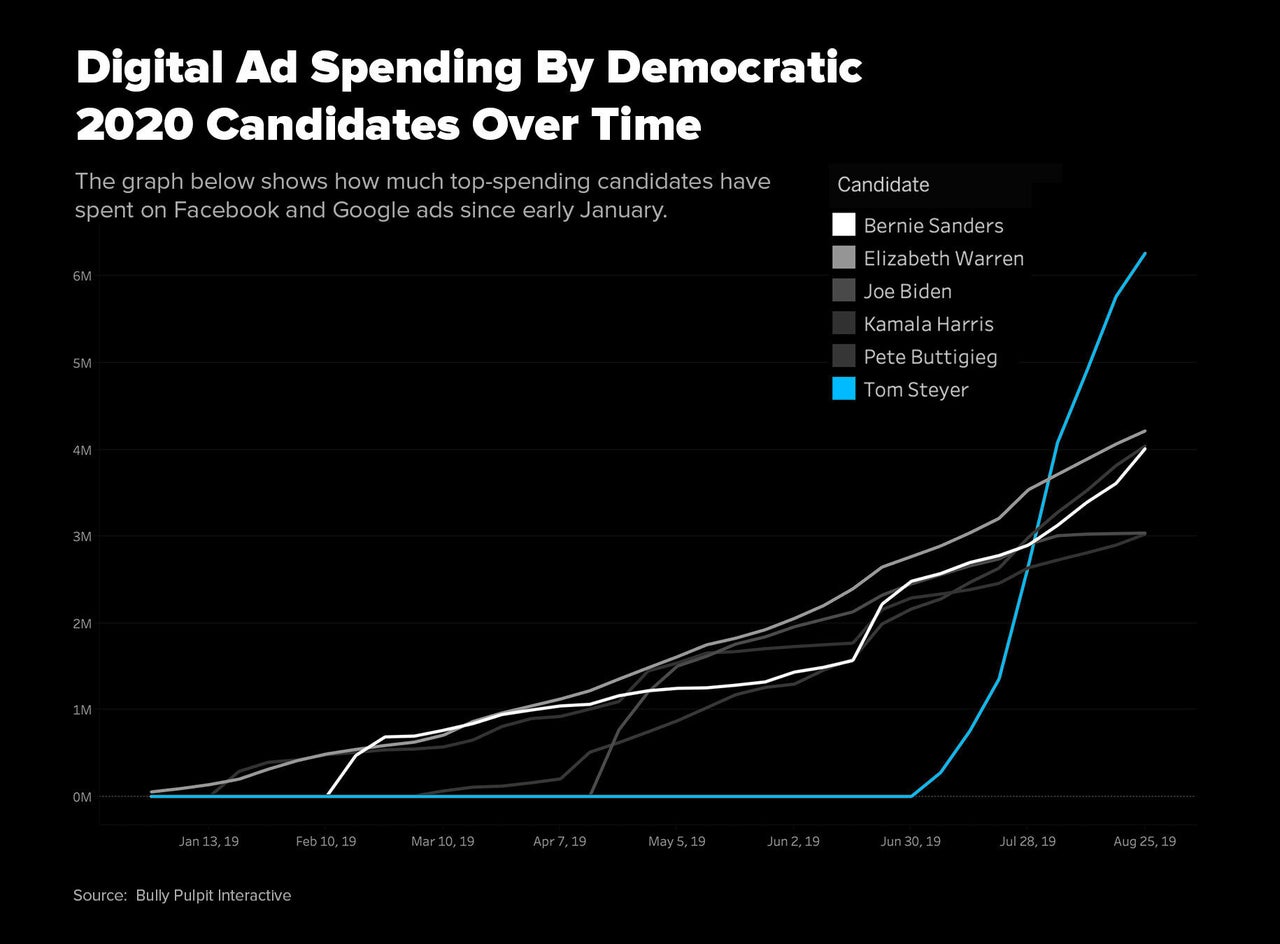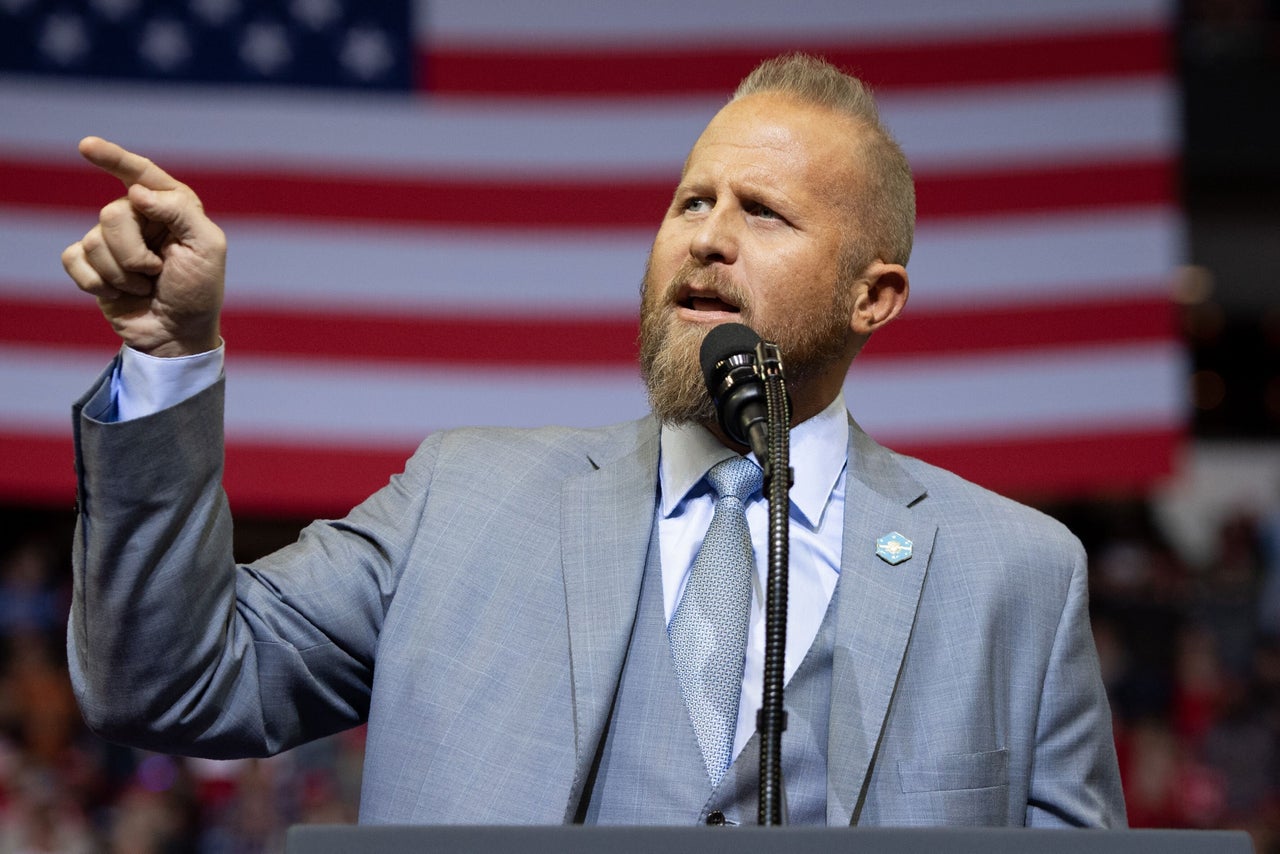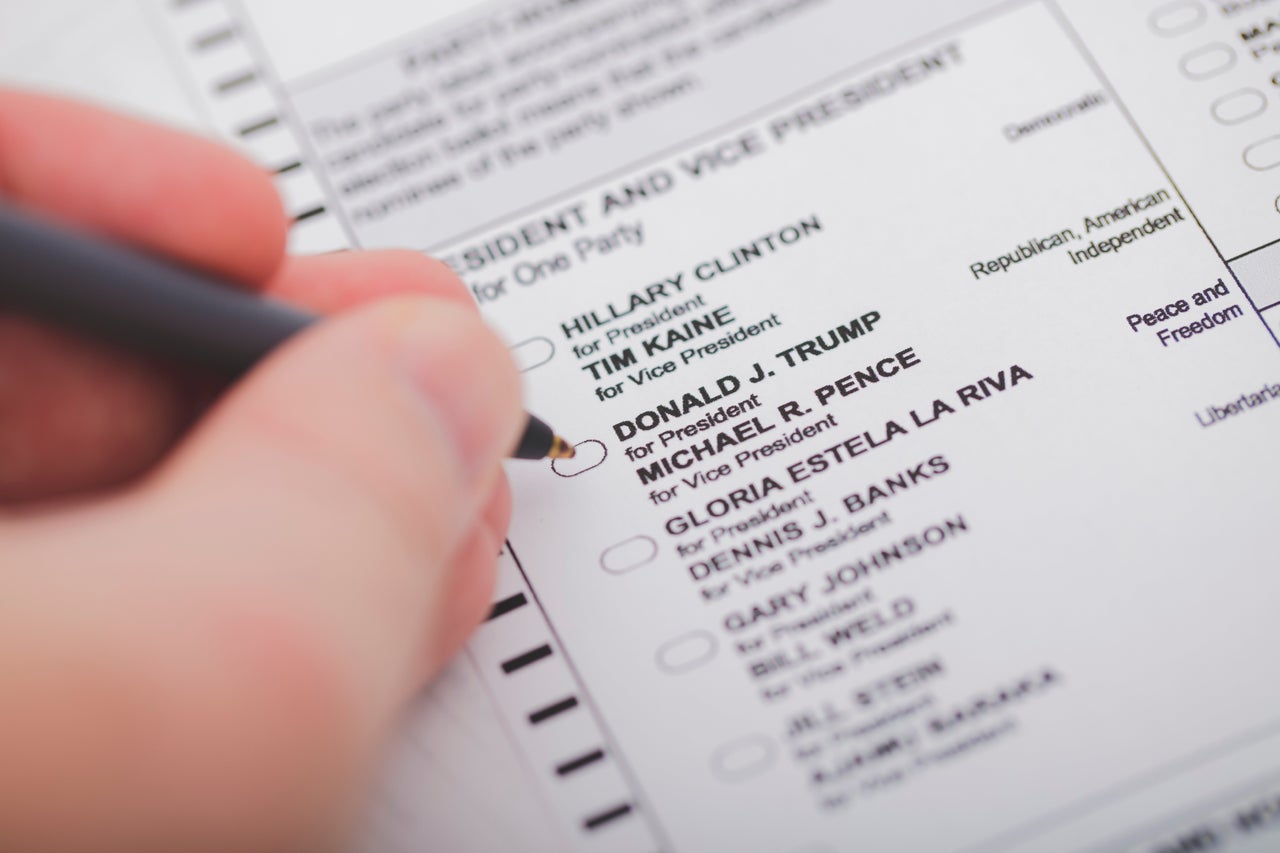At first, Tom Steyer’s late bid for the 2020 Democratic US presidential nomination hardly made a ripple in Washington DC. The little-known billionaire threw his hat into the ring on July 9, months after a crowded lineup of other Democrats had hit the campaign trail running. He seemed to drop in out of nowhere.
But within a matter of weeks, 62-year-old Steyer was polling at an astonishing 7% in early caucus and primary states — surpassing Kamala Harris, Pete Buttigieg, Beto O’Rourke and other big-name contenders. He even managed to secure a spot on Tuesday’s Democratic debate stage, where he’ll debut his platform before an audience of millions.
Steyer told HuffPost he credits his success thus far to having a message that resonates with voters as “important, true and different”. But the environmental activist and liberal mega-donor’s stunning leap from relative obscurity to national prominence can also be traced to a controversial campaigning tactic borrowed from President Donald Trump’s playbook: Funnelling big money into voter data collection and targeted digital political ads.
Since vowing to allocate at least $100 million of his own $1.6 billion fortune to his campaign, Steyer has already vastly outspent all of his competitors, and it’s paying off. So far, much of his money — more than $325,000 per day, according to The Wall Street Journal — has gone to political ads, including many that urged people to donate a single dollar to his campaign, quickly enabling him to hit the required 130,000 individual-donor mark. Millions of dollars worth of Steyer’s ads have also targeted voters in key states such as Iowa, South Carolina and Nevada. He polled well enough in those three states to get into Tuesday’s debate.
Beyond strategic geographic targeting, Steyer has invested heavily in data collection on millions of potential voters, his aides told The Atlantic, which has allowed him to target people with thousands of digital ad variations based on their individual interests.
Steyer’s team described his campaign strategy to HuffPost as being “aggressive across all digital platforms”, but critics have accused him of trying to buy his way onto the presidential ballot. And although he almost assuredly won’t win the Democratic nomination for president, Steyer’s ability to so effectively customise his messaging for different audiences and to excel in certain states so late in the game by bombarding them with ads is alarming and illuminating: It reveals how little progress advertising giants have made in addressing the dangers of so-called “micro-targeting” in the wake of Russian ad-targeting campaigns during the 2016 US election, and just how vulnerable American democracy remains to the influence of deep-pocketed actors.
“Micro-targeting can affect election results and it can undermine democracy,” said Michela Redoano, a targeted-advertising researcher and associate professor at the University of Warwick in England. “Most voters aren’t even aware of micro-targeting. If you buy a newspaper of a certain political leaning, you know to expect bias. But if you’re on social media, people aren’t necessarily expecting bias in the ads they see.”

How Political Advertisers Target Voters
Facebook and other platforms have profited massively by allowing ad buyers to select specific audiences and to tailor their ads accordingly. For example, you could run a custom Facebook ad campaign targeting single, college-educated, conservative-leaning women in their late twenties who live in Detroit and who are interested in yoga. The sites collect users’ data by tracking their online activity — ‘likes,’ profile information, search histories and so forth — to predict their interests, in turn giving companies and political campaigns extraordinary advantages for winning business and votes.
Democratic Senator Ron Wyden has called on Facebook and Google to ban micro-targeting for political ads — where the ad buyer’s intent may be more nefarious than selling yoga pants.
“Until the biggest tech companies can demonstrate that they have effective safeguards to prevent foreign governments weaponising their advertising systems, I believe they should voluntarily suspend the most dangerous and least transparent types of targeting for political and issue ads,” Wyden told HuffPost.
Micro-targeting isn’t a new practice, nor is it a tool used exclusively by foreign operatives. Political consultant Alex P. Gage, who coined the term in the early 2000s, founded a market research firm that worked with President George W. Bush’s 2004 reelection campaign to create targeted voter lists based on various criteria pulled from voter registries and other information sources. Bush’s team then contacted those voters by mail, phone or in-person.
But micro-targeting has become increasingly powerful in the age of digital advertising, especially as the number of Facebook users has continued to skyrocket over the years. It has become so powerful that some of the people who built targeted advertising tools are warning of a Frankenstein’s monster.
US democracy “is moving in a dangerous path where billionaires on both sides are investing in huge data operations, in manipulating individuals across the country through online ads”, Facebook’s former security chief, Alex Stamos, told CNN in August.
In 2013, researchers at the University of Cambridge and Stanford University conducted a study to determine just how effective artificial intelligence is at predicting people’s interests based off their digital footprints. By mining subjects’ ‘likes’ on Facebook, the researchers’ computerised system was able to assess their personality traits more accurately than the subjects’ own friends and family. Using such data to target and potentially manipulate voters can serve as a secret political weapon, allowing candidates to customise their messaging for just about any given audience for maximum impact.
We’ve seen how this plays out before.

The ‘Facebook Election’
About a year after winning the 2016 election, Trump told Fox News: “I doubt I would be here if it weren’t for social media, to be honest with you.” He was defending his use of Twitter as a political communication tool — one he credited with helping him get into office by allowing him to engage directly with voters. But there was a deeper truth to his words.
In the run-up to the vote, Trump’s campaign team created Project Alamo, a 220 million-person database containing information about Americans’ credit card histories, gun ownership and voter registration records, among thousands of other individual data points. Their information was reportedly obtained from the Republican National Committee and Cambridge Analytica — the firm that harvested millions of Facebook users’ data without their consent and sold it to political advertisers.
Project Alamo’s gargantuan collection of data profiles of potential voters enabled Trump’s team to launch hyper-targeted ad campaigns reportedly intended to discourage supporters of his opponent, Hillary Clinton, from voting, and to reach undecided voters in swing states.
“So now Facebook lets you get to … 15 people in the Florida Panhandle that I would never buy a TV commercial for,” Trump’s then-digital media director, Brad Parscale, told CBS News. “Twitter is how [Trump] talked to the people, Facebook was going to be how he won.”
In what has since come to be referred to as the “Facebook Election”, Russia also invested heavily in targeted political ad campaigns within the US, including some ads that targeted people in Michigan and Wisconsin specifically, per CNN — states pivotal to Trump’s victory. Other Russian ads were used to “encourage US minority groups not to vote”, according to a federal indictment. An estimated 10 million people in the US saw at least one of the thousands of political Facebook ads bought by Kremlin-linked accounts.
Trump, whose campaign spent tens of millions of dollars on Facebook ads during the 2016 election cycle, also took advantage of the platform’s “Lookalike Audiences” feature. The tool expands advertisers’ reach by identifying Facebook users who “have common qualities” and “are similar to” their existing custom audiences.
It worked. Targeted social media ads “were particularly successful” in persuading undecided voters to support Trump, and increased Republican turnout among key voter groups by as much as 10%, a 2018 study co-authored by Redoano found.
“You don’t need good policy as much now, you just need the money to run a good ad campaign,” said Redoano, who’s urging regulation surrounding micro-targeting.

No Real Change
Since the explosive impact of targeted ads in 2016, little has actually been done to install safeguards on major platforms. The Honest Ads Act, introduced by Democratic Senator Amy Klobuchar in 2017, would require political advertisers to disclose who their ads are targeting, but it stalled in the Senate.
Google and Facebook, both under intense scrutiny, have independently taken steps to increase transparency surrounding political ad campaigns on their platforms. Google, which directed HuffPost to its blog post about ad transparency, introduced a more stringent screening process for political advertisers. It now requires them to verify their information with a government-issued piece of ID and to disclose to viewers who’s paying for each ad.
After a Guardian investigation found that Facebook allowed advertisers to target users by their inferred, sensitive interests, such as Islam and homosexuality, the company announced it was removing “over 5,000 targeting options to help prevent misuse”, though it did not specify which options.
Facebook also now requires political advertisers in the US to disclose who paid for their ads. It recently announced that it is rolling out a “confirmed organisation” label for US advertisers who provide government-issued ID, and is requiring all political ad clients to list their contact information. The site debuted an online library of political ads last year, too, publicly cataloging messages about social issues and politics. The library does not, however, include detailed information about the ads’ targeting criteria.
Facebook did not respond to a request for comment.
Despite the improved transparency measures, Facebook users are still generally unaware they’re being targeted by political campaigns using a very sophisticated weapon. The last US presidential election was decided by 70,000 votes in three states, and similar narrow margins in 2020 would give talented purveyors of targeted advertising a tremendous opportunity to once again change the course of the election — and history.
